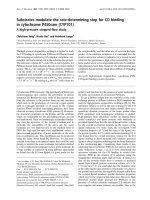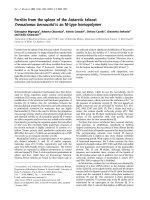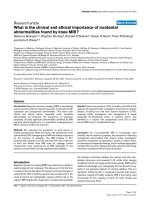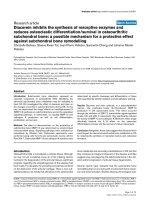Báo cáo y học: "What are the challenges of translating positive trial results in severe sepsis into clinical practice" pptx
Bạn đang xem bản rút gọn của tài liệu. Xem và tải ngay bản đầy đủ của tài liệu tại đây (40.45 KB, 4 trang )
ICU = intensive care unit; rhAPC = recombinant human activated protein C; SIRS = systemic inflammatory response syndrome.
Available online />This open discussion was arranged to raise awareness of the
common clinical syndrome of sepsis and the apparent
paradox between the successful development of the first
modifying agent for this syndrome – recombinant human
activated protein C (rhAPC) – and a perception that there
may be slow uptake of its use by clinicians. The participants
were as follows (see the appendix for affiliation details and
research activities): Jean-Louis Vincent, Antonio Artigas, Jan
Bakker, Tony Sherry and Michele Schroeder.
Background
Sepsis is considered to be a complex clinical syndrome
resulting from infection that gives rise to systemic
inflammation [1,2], although somewhat confusingly
nonmicrobiological tissue injury can precipitate an identical
clinical/pathophysiological picture. This is made all the more
difficult as confirming the presence of infection in critically ill
patients is often impossible [3]. When severe, sepsis
syndrome manifests as multiple organ dysfunction and is
associated with an approximately 30–50% mortality [4]. It is
perhaps the commonest condition presenting to intensive
care clinicians and accounts for as many deaths as
ischaemic heart disease or common cancers (Davies et al.,
unpublished data). Recent epidemiological and health care
economic surveys have estimated there to be 750,000 cases
of severe sepsis annually in the USA, which will rise to over a
million by the end of the current decade; at least 225,000 of
these cases result in fatality, with the annual cost of treating
severe sepsis in the USA estimated at $17 billion [5]. In the
European Union, the estimated number of fatal cases is
150,000 annually, and the cost of treatment $6.7 billion
(€7.6 billion) (Davies et al., unpublished data). Sepsis
syndrome has been, and remains, a major focus of intensive
care research and the subject of a large number of
international multicentre trials [6]. Despite these facts, there
is limited awareness of the condition among the general
public and health care providers. One of the explanations for
this is felt to be the confusing definitions and terminology
surrounding the condition [7], in particular the SIRS
diagnostic criteria [8], which have been the standard
Meeting report
What are the challenges of translating positive trial results in
severe sepsis into clinical practice? A media roundtable debate,
18 March 2002, Brussels, Belgium
Jonathan Ball
Lecturer in Intensive Care Medicine, Department of Anaesthesia & Intensive Care, St George’s Hospital Medical School, University of London, London, UK
Correspondence: Jonathan Ball,
Published online: 1 May 2002 Critical Care 2002, 6:271-274
© 2002 BioMed Central Ltd (Print ISSN 1364-8535; Online ISSN 1466-609X)
Abstract
The clinical syndrome of sepsis is common, increasing in incidence and responsible for as many
deaths annually as ischaemic heart disease. Two recent interventional trials have demonstrated that
early recognition and intervention can result in dramatic reductions in acute (28-day) mortality. This
roundtable discussion was convened to identify ways in which these recent advances could be
translated into clinical practice. The first obstacle surrounds the woolly and confusing terminology
surrounding ‘sepsis’ with the systemic inflammatory response syndrome (SIRS) model largely
discredited. Overcoming this should facilitate wider recognition, not only among health care providers
(in particular those working in acute specialties outside intensive care units [ICUs]) but also politicians
and the general public. Such education is vital if early recognition and intervention are to be
successfully implemented.
Keywords health resources, sepsis
Critical Care June 2002 Vol 6 No 3 Ball
diagnostic tool employed, especially in therapeutic trials.
However, SIRS has multiple deficiencies, not least that two
of the criteria are met performing normal daily activities such
as running for a bus (tachycardia and tachypnoea) [9]. The
widely used but problematic definitions of specific terms are
as follows: ‘sepsis’ is defined as the presence of infection
and SIRS; ‘severe sepsis’ is defined as ‘sepsis’ with organ
dysfunction; and ‘septic shock’ is defined as ‘severe sepsis’
with hypotension despite fluid resuscitation [8].
Two recent interventional trials have demonstrated that early
recognition and intervention can result in dramatic reductions
in acute (28-day) mortality. In March 2001, the first
successful, large scale, randomized, double-blind, placebo-
controlled trial of a therapeutic intervention in severe sepsis
was published [10]. This trial demonstrated that
administration of rhAPC to patients with severe sepsis, within
24 hours of diagnosis, reduced mortality by 6.1 % (from
30.8% in the control group to 24.7% in the treatment group).
This result indicates that 1 additional life would be saved for
every 16 patients treated. APC was approved for clinical use
in the USA in November 2001 and is expected to gain
approval in the European Union in the coming months. A
second major interventional study was also published in
November 2001 [11]. In this study, Rivers and colleagues
randomized patients with severe sepsis to either standard
care or protocolized, goal-directed therapy for the first 6
hours of treatment. They demonstrated a significant reduction
in 28-day mortality from 50% in the control group to 33% in
the protocol group, which remained significant at 60 days
with rates of 57% and 44%, respectively.
Roundtable discussion
The panel were presented with the following questions:
• First, ‘Does the panel agree with the findings of a recent
meeting of intensive care organizations, which concluded
that the SIRS model is too vague?’
• Second, ‘Does this panel feel that universal guidelines for
recognizing and defining sepsis would help identify
patients more effectively?’
• Finally, ‘Does this panel feel that the arrival of new sepsis
therapies means early identification and early treatment is
even more important? Do hospital teams need to be re-
educated about identifying and managing sepsis
patients?’
Vincent began by asking the panel to define sepsis. Artigas
proposed the view that sepsis is a syndrome of systemic
inflammation, which occurs in response to infection. He felt
that the SIRS criteria were too vague, failed to include vital
parameters, failed to consider the site of infection and failed
to usefully assess severity of illness. In response, Bakker
disagreed that the sepsis syndrome must always be the
result of infection as a nonmicrobiological cause of tissue
injury could precipitate an identical syndrome of organ
dysfunction. He also felt that the SIRS criteria are a useful
concept in the early identification of patients who may have
or are developing sepsis, a view supported by Schroeder and
Sherry. However, there appeared to be unanimous
agreement that the SIRS criteria were overly sensitive and
insufficiently specific to be used as diagnostic criteria for
sepsis in clinical practice or therapeutic trials.
The panel went on to discuss what elements should be
included in the definition of sepsis. Perhaps unsurprisingly,
they essentially recreated the ‘PIRO’ model. Vincent reported
that he had participated in the consensus conference held in
Washington, DC, USA, in December last year, which had
been arranged for the purpose of redefining the sepsis
syndrome [12]. He presented to the panel a brief outline of
the conference’s broader and more detailed, systematic
approach to sepsis definition, termed PIRO:
1 Predisposing factors: genetic, chronic disease,
immunosuppression, etc.
2 Infection (and/or nonmicrobial tissue injury?):
localized/extended/generalized.
3 Response: inflammatory cascades – limited/extensive/
very extensive.
4 Organ dysfunction: mild/moderate/severe score (Multiple
Organ Dysfunction Score [MODS] [13] or Sepsis-related
Organ Failure Assessment [SOFA] [14]).
The panel agreed that this approach was a real advance. In
particular, this model offers a useful framework from which to
educate both nurses and doctors. Vincent and Artigas
stressed that the ‘Response’ and ‘Organ dysfunction’ may,
initially at least, be very subtle, presenting with nothing more
than altered mental status or an isolated thrombocytopaenia.
The panel also expressed the vital need to be able to identify
patients as early as possible, specifically within the first
24 hours of their developing sepsis. Artigas reminded the
panel that epidemiological work has suggested that up to
50% of patients with sepsis are outside ICUs, and it is these
patients who are at greatest risk of being diagnosed late,
with consequently greater organ dysfunction/failure and
hence a higher morbidity/mortality. In response, Vincent
raised the issue of ICU outreach and questioned the panel
members about their institutions and experience of this. It
was generally agreed that outreach teams do facilitate earlier
recognition of septic patients, which inevitably leads to
increased admission pressures on ICUs. Bakker commented
that this increase is at least partially offset by a shorter length
of ICU stay, as the patients identified by outreach teams tend
to be less severely ill on reaching ICU. It also emerged that
best practice in this area remains undefined and that there
were finite limits to such a service (i.e. intensive care teams
cannot look after every patient in a hospital). This is of great
concern, as the incidence of sepsis appears set to continue
to increase substantially. The panel articulated the reasons
for this, identifying an ageing population and advances in –
and increased invasiveness of – medical therapies. Coupled
to all this is the public’s demand for more intervention; the
more done, the greater the risk of developing sepsis. Vincent
then raised the complementary solution, that of concentrating
educational efforts on health care professionals who work in
acute specialties outside intensive care. The panel concurred
with Artigas, who stressed the vital liaison between accident
and emergency services and ICUs.
The driving force behind early identification is the emergence
of the proven benefits of early intervention. Although not
discussed, the failure of many interventional studies in septic
patients may well be related to the inclusion of some or many
subjects with late/established organ dysfunction/failure. Such
patients can be considered ‘unsalvageable’, and hence have
negatively biased results. Crucially, the two recent,
successful, interventional studies have both specified early
interventions [10,11]. Bakker reported that the result of the
rhAPC trial has changed the approach of himself and his
colleagues. They now feel that there is an efficacious
additional therapy that can be given to patients with severe
sepsis/septic shock, if identified early enough. Hence, in their
ongoing, international, multicentre, open-label study of rhAPC
in severe sepsis, Bakker and colleagues actively consider
whether each patient fulfils the criteria for entry into the
study; in short, there is more of a reason to make an early
diagnosis as something positive can be instituted. Artigas
concurred but also stressed the proven benefit of early
resuscitation as established by Rivers and colleagues [11].
The panel also agreed that a significant proportion of septic
patients have failed the inclusion/exclusion criteria of the
rhAPC trials. Sherry reported that only 13% of the patients
screened at St Thomas’ have been entered into the Open
Label study. Bakker reported that the inclusion rate was far
higher in The Netherlands, and suggested that this may be
due to the greater availability of ICU beds, in comparison to
the UK. The panel agreed that the efficacy of rhAPC needs to
be established in many of these excluded patients. There was
also a consensus that such therapies require ICU monitoring
to be administered safely.
The panel concurred that studies into the long-term outcome
of patients with severe sepsis who survive to hospital
discharge were lacking and urgently needed. Artigas
commented that from what evidence does exist, it appears
that such patients have ongoing morbidity (such as functional
limitations), at least for several months, following hospital
discharge. This raised the issue of what, if anything, is known
about the optimal care of these patients, the impact on their
families and who should best care for them. The panel were
unanimous that these patients required specialist, proactive
care, but felt that this additional work could not be adopted
by intensivists.
On a final note, the panel concluded that educating the
general public and politicians must be a priority. The
ignorance and misunderstanding surrounding sepsis was
profound and threatened to diminish the potential impact of
adopting novel therapies/strategies in the treatment of this
common and serious syndrome.
Conclusion
The confusing terminology and woolly definitions
surrounding sepsis have undeniably had a variety of negative
effects. The emerging PIRO model offers the opportunity to
reverse this and educate not only health care professionals
but also the general public. Development and increasing
promotion of educational initiatives such as the Fundamental
Critical Care Course (FCCS) [15] and the Acute Life
Threatening Emergencies – Recognition and Treatment
(ALERT) [16] courses must be encouraged and resourced.
The fact that the sepsis syndrome is so common and
associated with such a high mortality needs to be
communicated far more effectively, not least as a number of
effective early treatments/treatment strategies have recently
emerged. What remains unclear, at least to some clinicians,
is to which patients with sepsis syndrome emergent
therapies such as rhAPC should be given. The results of the
recent early goal-directed therapy [11] and intensive
glycaemic control trials [17] have demonstrated the
dramatic effects on mortality that relatively simple
interventions can have. However, there remains a strong
argument, based both on basic science research [18] and
the Recombinant Human Activated Protein C Worldwide
Evaluation in Severe Sepsis (PROWESS) study [10], for
patients with severe sepsis to receive rhAPC. In view of the
fact that it seems unlikely that a further study comparing
best simple care with best simple care plus rhAPC will be
undertaken, it is impossible to determine the relative and
additive value of each of these interventions. The major
difference between these interventions is cost with early
goal-directed therapy essentially cost neutral, whereas a
treatment course of rhAPC will cost approximately
US$6600 per patient [19]. The economic impact of
widespread rhAPC use may deter clinicians and/or budget
holders from implementing this therapeutic strategy.
Biochemical or genetic markers, yet to be defined, may
facilitate the identification of patients most likely to benefit,
although, notably, using APC levels failed to discriminate in
the PROWESS trial. As is all too frequently the case, the
questions and aspirations continue to outstrip the answers
and resources, and yet signs of positive progress in the
management of patients with severe sepsis have finally
emerged.
Competing interests
JB received an honoraria and expenses from Eli Lilly and
company to attend and report on this roundtable debate.
Acknowledgements
This meeting was fully supported by an educational grant from Eli Lilly
and Company, the makers of rhAPC (Xigris™).
Available online />References
1. Abraham E, Matthay MA, Dinarello CA, Vincent JL, Cohen J, Opal
SM, Glauser M, Parsons P, Fisher CJ Jr, Repine JE: Consensus
conference definitions for sepsis, septic shock, acute lung
injury, and acute respiratory distress syndrome: time for a
reevaluation. Crit Care Med 2000, 28:232-235.
2. Farinas-Alvarez C, Farinas MC, Fernandez-Mazarrasa C, Llorca J,
Delgado-Rodriguez M: Epidemiological differences between
sepsis syndrome with bacteremia and culture-negative
sepsis. Infect Control Hosp Epidemiol 2000, 21:639-644.
3. Vincent JL, Mercan D: Dear Sirs, what is your PCT? Intensive
Care Med 2000, 26:1170-1171.
4. Angus DC, Wax RS: Epidemiology of sepsis: an update. Crit
Care Med 2001, 29(suppl):S109-S116.
5. Angus DC, Linde-Zwirble WT, Lidicker J, Clermont G, Carcillo J,
Pinsky MR: Epidemiology of severe sepsis in the United
States: analysis of incidence, outcome, and associated costs
of care. Crit Care Med 2001, 29:1303-1310.
6. Graf J, Doig GS, Cook DJ, Vincent JL, Sibbald WJ: Randomized,
controlled clinical trials in sepsis: has methodological quality
improved over time? Crit Care Med 2002, 30:461-472.
7. Matot I, Sprung CL: Definition of sepsis. Intensive Care Med
2001, 27(suppl 1):S3-S9.
8. American College of Chest Physicians/Society of Critical Care
Medicine Consensus Conference: Definitions for sepsis and
organ failure and guidelines for the use of innovative thera-
pies in sepsis. Crit Care Med 1992, 20:864-874.
9. Vincent JL: Dear SIRS, I’m sorry to say that I don’t like you. Crit
Care Med 1997, 25:372-374.
10. Bernard GR, Vincent JL, Laterre PF, LaRosa SP, Dhainaut JF,
Lopez-Rodriguez A, Steingrub JS, Garber GE, Helterbrand JD, Ely
EW, Fisher CJ Jr: Efficacy and safety of recombinant human
activated protein C for severe sepsis. N Engl J Med 2001, 344:
699-709.
11. Rivers E, Nguyen B, Havstad S, Ressler J, Muzzin A, Knoblich B,
Peterson E, Tomlanovich M, and the Early Goal-Directed Therapy
Collaborative Group: Early goal-directed therapy in the treat-
ment of severe sepsis and septic shock. N Engl J Med 2001,
345:1368-1377.
12. Vincent JL: Reflection and reaction: sepsis definitions. Lancet
Infect Dis 2002, 2:135.
13. Cook R, Cook D, Tilley J, Lee K, Marshall J: Multiple organ dys-
function: baseline and serial component scores. Crit Care Med
2001, 29:2046-2050.
14. Vincent JL, Moreno R, Takala J, Willatts S, De Mendonca A, Bruin-
ing H, Reinhart CK, Suter PM, Thijs LG: The SOFA (Sepsis-
related Organ Failure Assessment) score to describe organ
dysfunction/failure. On behalf of the Working Group on
Sepsis- Related Problems of the European Society of Inten-
sive Care Medicine. Intensive Care Med 1996, 22:707-710.
15. Fundamental Critical Care Support Course. [m.
org/edu/fccscourses.html].
16. Smith G: ALERT (Acute Life Threatening Emergencies – Recogni-
tion & Treatment) course. 2001: [ />wpgood.nsf/78fa470b980dd9040025699e0052e520/63392cc
488a5c817802569ee0052ed84?OpenDocument].
17. Van den Berghe G, Wouters P, Weekers F, Verwaest C, Bruyn-
inckx F, Schetz M, Vlasselaers D, Ferdinande P, Lauwers P, Bouil-
lon R: Intensive insulin therapy in critically ill patients. N Engl J
Med 2001, 345:1359-1367.
18. Opal SM: Clinical impact of novel anticoagulation strategies in
sepsis. Curr Opin Crit Care 2001, 7:347-353.
19. Cost-effectiveness of drotrecogin alfa (activated) (Xigris™) in
severe sepsis. Crit Care Med 2002, 30:492-493.
Appendix
Chairman: Jean-Louis Vincent, Head of Department of
Intensive Care, Erasme Hospital, Brussels, Belgium. Vincent
was a participant at the sepsis definition consensus
conference (December 2001, Washington, DC, USA), and is
one of the Recombinant Human Activated Protein C
Worldwide Evaluation in Severe Sepsis (PROWESS) study
investigators.
Antonio Artigas, Director of Intensive Care, Sabadell
Hospital, Barcelona, Spain.
Jan Bakker, Director of Intensive Care, Isala Klinieken Zwolle,
Zwolle, The Netherlands. Bakker is a study investigator in the
ongoing international, multicentre, open label study of rhAPC
in severe sepsis (phase 3b clinical trial).
Tony Sherry, Senior Research Nurse, Guy’s & St Thomas’
Trust, London, UK. St Thomas’ is the leading UK centre in the
ongoing international, multicentre, open-label study of rhAPC
in severe sepsis (phase 3b clinical trial).
Michele Schroeder, Senior Research Nurse, Department of
Intensive Care, Erasme Hospital, Brussels, Belgium.
Schroeder was involved in the PROWESS study.
Critical Care June 2002 Vol 6 No 3 Ball









